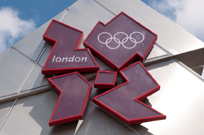The Controversial Aquatics Venue

 The distinctive London Aquatics Centre for the 2012 Olympic Games will seat 17,500 spectators and boast two 50-meter swimming pools, one 25-meter diving pool and various training facilities. Competitions slated to take place in the center are swimming, diving, synchronized swimming and water polo. Swimming events at the separate 2012 Paralympics — which will take placefollowing the Olympics — will also be held in the venue.
The distinctive London Aquatics Centre for the 2012 Olympic Games will seat 17,500 spectators and boast two 50-meter swimming pools, one 25-meter diving pool and various training facilities. Competitions slated to take place in the center are swimming, diving, synchronized swimming and water polo. Swimming events at the separate 2012 Paralympics — which will take placefollowing the Olympics — will also be held in the venue.
From the start,the aquatics center has engendered a considerable amount of controversy. For one thing, many people doubted that the design — created by world-renowned British-Iraqi (and female) architect Zaha Hadid — could ever be built due to its highly complex nature.
The main contractor on the project has been Balfour Beatty, a London-based infrastructure-services firm with major projects throughout the world. Since taking on the aquatics center, the company seems to have overcome both the skepticism and the practical obstacles.
But not without a skyrocketing price tag. Perhaps the most controversial aspect of the center’s construction has been the hugecost overruns that have resulted. The center was originally supposed to cost 75 million (around $120 million), but the current estimate of the final price tag is 278 million (around $444 million). Still, the London Olympics reportedly will be ready on or before schedule and within the total allocated budget.
Anothermain point of contention has been what to do with the aquatics center once the Olympics and Paralympics are over. The people of the U.K. — and Londoners in particular — were assured that, unlike with a number of previous Olympic Games, the enormously expensive structures built for the 2012 event would not simply be torn down or left to decay, but would be put to productive uses that would enhancethe lives of the local population.
As an article published on the Web site guardian.co.uk at the beginning of this year put it, “For an event that was largely awarded on its legacy promises, the next few months will be key to deciding whether the 2012 Games will usher in the bold regeneration of London’s East End and a string of first-class elite sport venues or an increasing drain on the public purse propping up a mixed bag a facilities.”
The mammoth Olympic Stadium appears to be relatively unproblematic when it comes to being converted to public use following the Games; a number of offers have already been made. The Aquatics Centre, however, is shaping up to be a different proposition.
From the very beginning, there was a request that the design keep open thepossibility of installingwave machines and slides in the post-Olympics era. According to The Guardian, “…because of the increased cost and the constraints of the building, the plea was ignored. Instead, those bidding for the pool will be asked to consider how they could provide ‘portable’ leisure features to make it more attractive to families.”
One thing is becoming increasingly evident: The Aquatics Centre in its post-Games incarnation will likely need public subsidies to survive, given an estimated 1 million ($1.6 million) annual maintenance bill alone.
David Sparkes, CEO of British Swimming (the governing body for swimming and related activities in Great Britain), said in the Guardian piece: “There is a cost to pools in the same way as there is a cost to libraries and museums. It’s a public asset. There was never a moment when we didn’t believe we would need a subsidy for the pool. Every public pool needs a subsidy.”
The final chapter in the London Aquatics Centre story has yet to be written.
Video: The engineering challenges posed by the center’s complex design have been formidable. To watch a video about the structure’s unusual engineering requirements — especially with regard to the roof — click here. This report was first broadcast last month on The Discovery Channel Canada.
Renderings: To see numerous imagesof how the center will appear once completed — both inside and out — click here.
Animation: To watch an animation of what the center will look like, click here.









